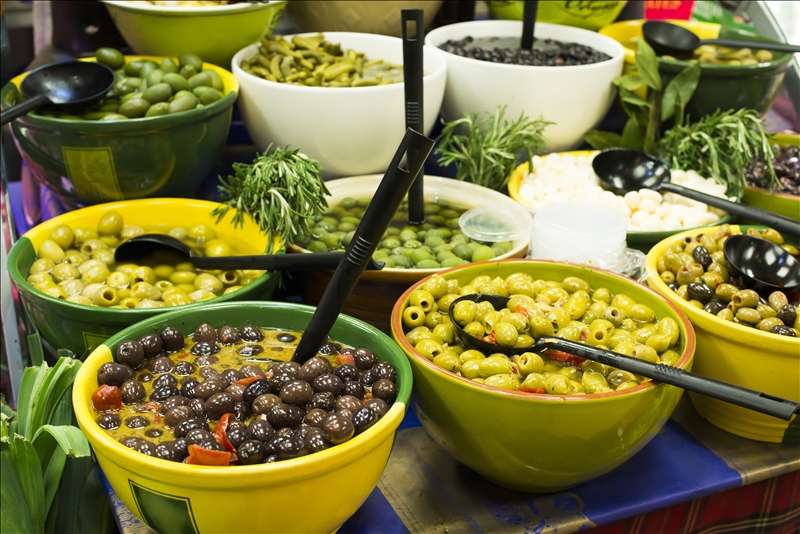Guest post by Kit Broihier, MS, RD, LD
Courtesy of the Maine Academy of Nutrition and Dietetics
Continuing with the Mediterranean eating theme practically requires that we cover olives and olive oil at some point in the discussion, since they are so widely consumed by Mediterranean cultures. Traditionally, a Mediterranean diet calls for eating several olives (maybe up to 10) or consuming 2-3 tablespoons of olive oil each day. Let’s take a look at what the benefits of this practice may be.
Are there health benefits from olives that are separate from their oil?
This is the first question I had when starting this post. After all, most dietitians can rattle off several benefits of consuming olive oil without much trouble at all, but olives themselves? I tend to think of olives as mostly a garnish of sorts, not really a food, but in the Mediterranean diet they are indeed a food. Olives are rich in phytonutrients that exhibit anti-inflammatory and antioxidant effects. A recent study even shows that compounds in olive leaves may help increase insulin sensitivity (though the study used capsules and not olives themselves). In fact, one company is seeking a patent for the olive leaf extract, which is a more potent source of the two phytonutrients of interest—oleuropein and hydroxytyrosol—for its effects in the blood sugar control/metabolic syndrome area. These phytonutrients may also play a role in cancer prevention, and are known to have some blood thinning properties. It’s a bit early to jump on the olive leaf extract bandwagon, but it certainly presents some rationale for including more olives in your diet. Olives are also a good source of fiber, iron, copper and vitamin E.
Now to rattle off the olive oil health benefits
Most of the health chatter around olive oil relates to the fact that it is mainly made up of monounsaturated fatty acids (MUFAs). These are considered healthy dietary fats, and when you decrease your consumption of less healthy fats (such as saturated and trans fats) with MUFAs, you can help lower your risk of heart disease by lowering total cholesterol and “bad” LDL cholesterol levels. There is also some evidence that suggests that MUFAs may benefit blood sugar control as well—great for those with metabolic syndrome or Type 2 diabetes. In fact, studies like this recent one have shown that a Mediterranean diet that includes olive oil and nuts—without energy (calorie) restriction—reduced diabetes risk in a group of adult men and women who were already at risk of cardiovascular disease. Some types of MUFAs appear to have a use in fighting breast cancer, though more studies need to be done before conclusive benefits are demonstrated.
Bringing it to the table
Olives or olive oil for you? Both have benefits, and many of them are the same. So it may come down to sodium. Olives are usually high in sodium, though the level varies by type and processing technique. Most olives are brined and cured for several months to offset their naturally bitter taste. This means, of course, that they are salty—and rinsing them does little good. If you’re one of those folks who needs to watch sodium, you may want to go the olive oil route instead of the olive route when following a Mediterranean eating plan.
When choosing olive oil, keep these things in mind:
- Extra virgin olive oil (EVOO) has the highest concentration of health-promoting phytonutrients. It’s made by crushing/pressing the olives, and is the first extraction of the oil from high quality olives. Choose EVOO for drizzling, dipping or dressings.
- Light olive oil, though not worthy of the extra virgin quality label, is still olive oil (albeit likely a mixture of different olive oils) and has comparable health benefits. It is further refined than EVOO, resulting in a more colorless, more mild-tasting oil. It’s better suited to cooking with high heat as its smoke-point is higher than that of EVOO. It’s also a good choice for baking.
Note from Diane
What’s your favorite olive? What’s your favorite olive? I did a taste test at Micucci Grocery in Portland and discovered a new one. Check out the video and also get some olive trivia.
[/fusion_builder_column][/fusion_builder_row][/fusion_builder_container]




Leave A Comment